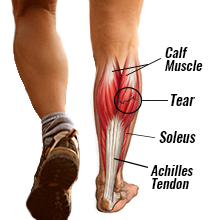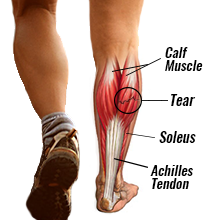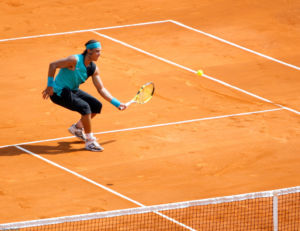 The calf muscle is found at the back of the lower leg and is comprised of three muscles: the plantaris, the gastrocnemius, and the soleus. These 3 muscles are referred to as ‘the triceps surae’, and they attach to the Achilles tendon.
The calf muscle is found at the back of the lower leg and is comprised of three muscles: the plantaris, the gastrocnemius, and the soleus. These 3 muscles are referred to as ‘the triceps surae’, and they attach to the Achilles tendon.
They are responsible for extending the foot (plantar flexion) and bending the leg at the knee joint.
The Achilles tendon attaches to the heel bone (the calcaneus). The soleus sits deep to the gastrocnemius, with the plantaris muscle and part of its tendon located between these two muscles.
What is calf muscle strain?
Calf muscle strain occurs when the muscle at the back of the lower leg becomes damaged or inflamed due to excessive strain or force being placed on the calf muscle. When a muscle is stretched, small micro tears occur in the muscle fibers. The severity of these tears depends on the depth and suddenness of the stretch.
There are three different degrees of calf muscle strain:
Grade 1 is a mild strain
Grade 2 moderate to severe pain
Grade 3 strain is a complete rupture
Sudden push off movement or excessive over-stretching of the calf muscles as demonstrated during quick changes of direction result in calf injuries or tear in calf muscles. This is also common in sports such as football, tennis, and squash due to the rapid acceleration from a stationary position seen in these sports.
What causes strain in calf muscles?
- Sudden large force or pressure to the calf.
- Improper or insufficient warm up or cool down is a common cause of calf strain
- Climbing or running up hills.
- Wearing inappropriate footwear or using an inappropriate equipment.
- Excessive acceleration from stationary and lunging.
Signs that show you are suffering from strain in calf muscles
- Sudden pain in the calf muscle
- Pain when resuming activity
- Swelling and inflammation
- Aching and stiffness
- Abnormal appearance of the calf
- A sudden sharp pain in the lower leg.
- Pain/ache in the calf, usually mid calf.
- A sensation of being hit on the back of the lower leg.
- Inflammation of the lower leg.
- Difficulty in weight bearing.
Treatment for calf muscle strain
It is important not to ignore a calf strain, as this could cause further damage and lead to a grade 3 strain. The earlier the treatment, the better the outcome. So, here are some steps to follow which can be used to treat calf muscle sprain in a better way
RICE method
RICE stands for Rest, Ice, Compression, and Elevation.
Rest: Give rest to the affected part. Take a break from any activity that may be causing your pain.
Ice: Apply the ice or cold pack for 10 to 20 minutes, 3 or more times a day to minimize the pain and swelling. After 48 to 72 hours, if swelling is gone, apply heat to the area that hurts. Do not apply ice or heat directly to the skin. Place a towel over the cold or heat pack before applying it to the skin.
Compression: Wrapping the injured area with an elastic bandage will help to reduce swelling. Don't wrap it too tightly, because this can cause more swelling over the affected area. Loosen the bandage if it is too tight.Talk to your doctor if you think you need to use a wrap for longer than 48 to 72 hours; a more serious problem may be present.
Elevation: Elevate the affected area on a pillow while applying ice and anytime you are sitting or lying down. Try to keep the injured part above the heart level to help minimize swelling.
Anti-inflammatory medication
NSAIDS (anti-inflammatories) and paracetamol can be taken to aid pain relief. Medical advice should be sought, in case of possible side effects.
Heel pads
Wearing heel pads during calf muscle strain or injury helps to recover it faster. heel pads support the calf muscles, raise the heel and shorten the calf muscle hence taking some of the strain off it.
Physiotherapy
A physiotherapist or sports therapist can advise when exercise should be resumed and what exercise would be appropriate. He might prescribe ultrasound treatment, sound waves; which speeds up the repair process, by breaking down tissues and stretching them. It can also help alleviate pain. An MRI scan might be recommended by the therapist to assess the extent of rupture. In severe cases, surgery might be performed.
Massage Therapy
Massage can help aid recovery, and improve joint mobility and range of movement. It should not be administered during the acute stage. If there is any underlying medical condition, such as a heart condition, it is important to seek medical advice before receiving massage therapy.
Related article: Achilles Tendinitis- How can Physiotherapy help?


